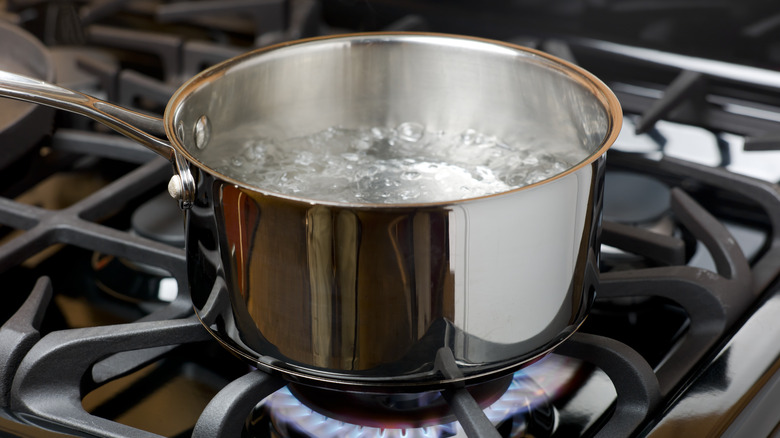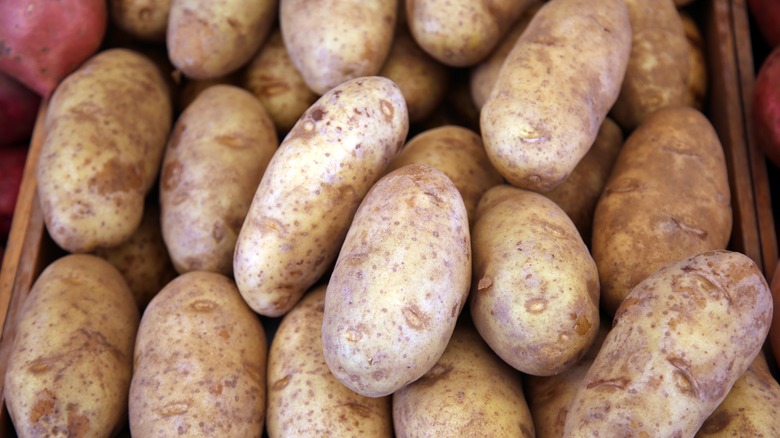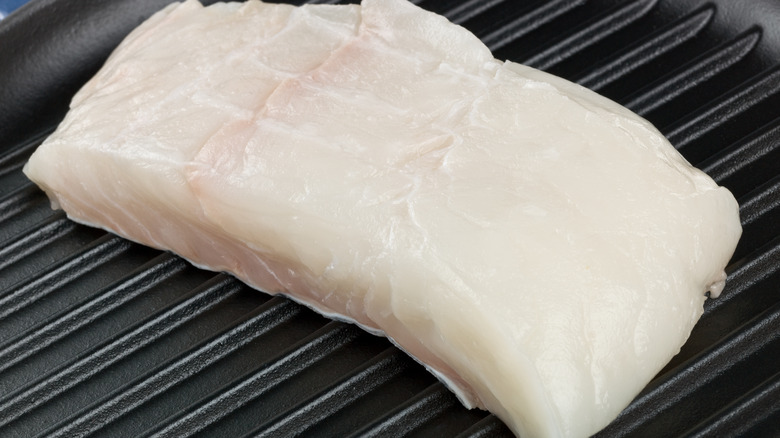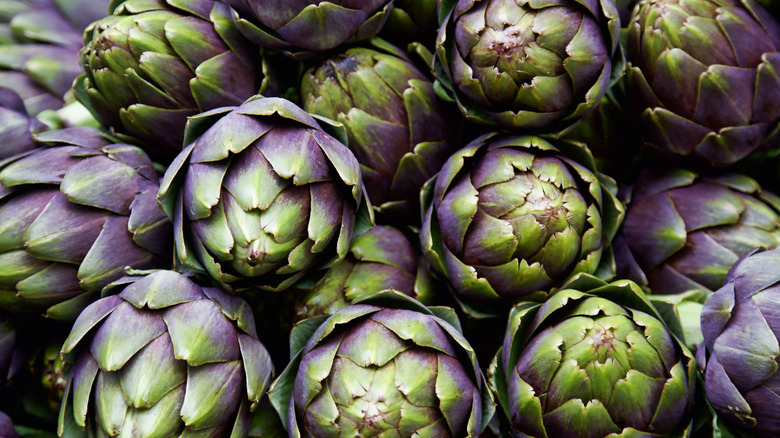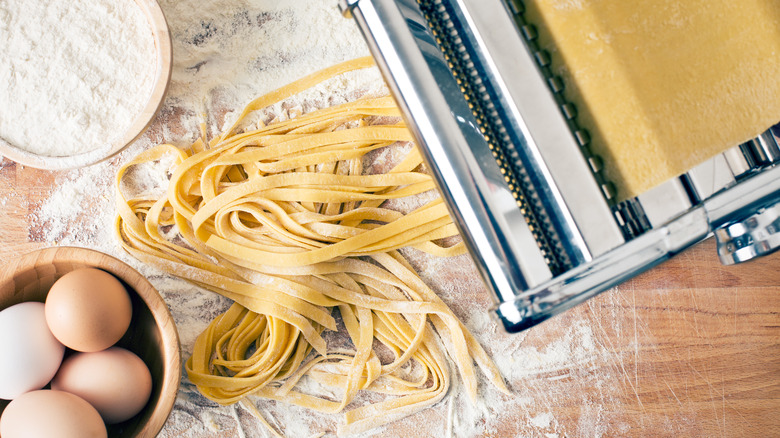13 Foods You Need To Stop Boiling In Water
Boiling is one of the first cooking techniques that most people learn. The act of placing food in hot water to prepare a meal has been around for millennia. Archeologists have found potential evidence of pits used to cook food in boiling water that may be up to 30,000 years old. It's clear to us why it's remained one of the go-to forms of cooking. Boiling food in water is not only one of the easiest ways of cooking it, but it's also one that takes barely any resources: All you need is a pan, your food, some water, and a heat source.
Boiling food also has some digestive benefits. It helps to break down the items' cell structures, making foods easier to digest. As a method that requires no additional fat, boiling can also be a lighter and healthier method of preparation than sautéeing or stir-frying.
But while boiling may work very well for your eggs and dried beans, it's far from the best option for all foods. Boiling certain types of food in water can completely ruin their texture. It can even cause them to be far less nutritious than you might expect. Other foods can be made completely tasteless if you're boiling them in water alone.
1. Potatoes
It's pretty common to boil potatoes. Not only are boiled potatoes a common side dish on their own, but doing so is also a popular step in the process of making mashed potatoes, or getting the fluffiest roasted potatoes imaginable. So it might surprise you to learn that you probably shouldn't be boiling potatoes at all, or any root vegetable for that matter.
Root vegetables, like potatoes, carrots, and beets are denser than others and take longer to cook. When they're heated up rapidly in boiling water, their outsides can therefore become too mushy before their insides have a chance to cook, and you can end up with an uneven result. It's worth pointing out that this doesn't necessarily mean that you can't boil root vegetables at all — rather, you have to be careful how you do it, not plunging them into boiling water straight off the bat, and starting with cold water. Using cold water and gradually heating up your potatoes will cause the enzymes in the vegetable to firm it up somewhat, meaning you get a more consistent cook.
The best thing to do, however, is to steam your potatoes. This is a far more gentle cooking method that gradually heats your potatoes through. According to Runner's World, steaming also locks the nutrients in more effectively.
2. Couscous
As anyone who's prepared couscous before knows, you won't get very far without hot liquid. It's vital to add hot water or broth to couscous to cook it, but it's important to stop short of actually boiling the couscous itself. While couscous is a type of pasta, it doesn't need the same consistent rolling heat that larger pieces do, and should never be boiled. If you try and do this, you'll find that your couscous turns into mush incredibly quickly.
Instead, the aim with couscous is to rehydrate it using a small amount of hot liquid. Covering the couscous while it sits in the liquid helps to trap in heat and steam, which will help to make it plumper — but the aim is not to make it hotter, just maintain the heat you already have. Importantly, though, this may not be the case with all types of couscous. While regular couscous doesn't come out best when boiled, larger types, like giant couscous, may require boiling to fully cook it.
Remember, too, that with regular couscous, adding plain water to it might give you a pretty plain result. Couscous benefits from a bit of extra flavor. Using stock or a spice-infused broth might be a good choice.
3. Broccoli
For some people, the thought of limp, dull, boiled broccoli is enough to put them off the vegetable for life. Those folks will be pretty vindicated by what we'll say next: That broccoli should never have been boiled in the first place.
Boiling broccoli, and other vegetables, reduces their nutritional value. "Boiling vegetables causes water soluble vitamins like vitamin C, B1 and folate to leach into the water," registered dietitian Elaine Magee told CNN. When that water is poured away — unless, as Magee states, you're cooking your broccoli in a soup or stew — the nutrients go with it.
This loss of vitamins and other helpful nutrients was observed in a study published in the Journal of Zhejiang University, which looked at the effects of different cooking methods on broccoli's overall healthiness. The researchers found that boiling broccoli reduced its vitamin C content significantly. Boiling also lowered the amount of glucosinolate (compounds that may have antioxidant and anti-inflammatory effects) in broccoli. On the other hand, steaming broccoli allowed the vegetable to hold onto its nutrients well. Overall, it was the cooking option that left the broccoli at its most nutritious.
4. Yuca
Yuca — also known as cassava — is a carb that has a lot of bang for its buck. This root vegetable, which has a mild, slightly sweet flavor, is full of resistant starch and beta-carotene. These ingredients can increase digestive health and improve your body's defense against free radicals respectively, according to WebMD. On top of this, yuca is a super-versatile tuber. It can be served mashed, fried, and roasted — in addition to other preparations.
But what you really shouldn't be doing with yuca is boiling it in water. Yuca has a fairly gentle flavor, and by boiling it in water, you end up ruining the subtleties of it and turning it into a bland mess. Boiling yuca too aggressively can also make it way too soft, potentially ruining its texture.
Instead, it's better to cook it in ways that enhance its flavor, rather than diminish it. "[We] poach yuca prior to frying because it incorporates more flavor into it," says Vie, Vistro, and Gaijin chef Paul Virant via The Kitchn. Additionally, yuca is a good source of vitamin C. This water-soluble vitamin can be lost when boiling it in water for too long. Poaching it at a more gentle heat may help to retain more of its vitamins.
5. Rice
We realize this one might raise some eyebrows, given that your go-to method for cooking rice might be to tip it into boiling water. But the best way to cook it is far more gentle.
Rather than cooking rice in a pot of boiling water and then draining it, chef and rice connoisseur Peter Sidwell recommends opting for the absorption method instead, according to Express. Rather than using copious amounts of boiling water, you only use slightly more water than the rice you have. Bring it to a boil, turn it down, and allow the rice to absorb all the liquid, finishing off in its own steam. By using this absorption method, you allow the rice to retain all of its starchiness, which makes it fluffier and stickier. You also lose less of the nutrients in the rice grain itself, as you're not pouring away any that have seeped out into the water.
However, there is one exception to this rule. While absorption works for more tender grains like jasmine, glutinous, and basmati rice, brown rice generally needs a little more vigor to cook. You might find it easier to boil brown rice, adding more water as you need to.
6. Chicken
Meat is commonly cooked in liquid — from braised short ribs simmered in broth to ground beef bubbling away in a chili. Chicken, like other meats, is awesome when cooked in liquid — unless that liquid is boiling water. Boiling chicken, especially leaner cuts like its breast, in water, can result in dry, rubbery meat, as the muscle fibers firm up in response to the high heat. If you're placing the chicken in unseasoned water, not only will your chicken be tough, but it'll be flavorless, too.
The key to cooking chicken in liquid is to opt for a slightly lower temperature and poach it. Poaching cooks food by placing it in barely simmering water or broth, thereby exposing it to a gentle, yet consistent heat. By cooking chicken in this way, you won't need to worry about overcooking the surface, while the inside remains raw. The meat will cook slowly and gently, staying tender and moist throughout.
While you can technically poach chicken in water, doing so in a broth will allow the flavor to seep into it, preventing any potential blandness. Your broth can be as simple or as complex as you'd like — most anything will be better than plain water.
7. Grits
Grits are the perfect accompaniment to a meal. When they're done right, they may even be the best part of your dish. But boiling them in water will leave you disappointed. When you boil grits in plain water, you're not adding any flavor to them whatsoever. This can make your grits (which have a pretty neutral flavor anyway) incredibly bland, and a chore to get through. While you can, of course, season your grits after cooking, you run the risk of anything you add being poorly incorporated.
The best thing to do is to mix your water with stock, milk, or cream — all of which will imbue your grits with more flavor. Using a dairy liquid works very well for grits, as it adds a richness to the dish which complements the subtle sweetness of the cornmeal. Bear in mind, though, that while it might be tempting to use just stock or milk instead of diluting them with water, things may go awry.
"Cooking grits in all milk or chicken stock imparts too much of those flavors into the grits," Southern Living Test Kitchen Director Robby Melvin told the magazine. Be wary of using too much cream, too, as this may make your grits too thick and porridge-like.
8. Rice noodles
Rice noodles, like egg and wheat noodles, come in all shapes and sizes. But they're well-known in their ultra-thin vermicelli form, which can be an ingredient in everything from spring rolls to noodle soup. If you have rice vermicelli, though, you're likely not going to want to boil them in water. Placing these noodles in a bubbling pot is a surefire way to ruin them, as their thinness — combined with the fierce heat — means that they'll overcook fast, leaving you with a gelatinous, oversoft result.
This can also be the case with slightly thicker rice noodles. Generally, most rice noodles can cook perfectly well by just adding warm water to them and allowing them to soak for a little while. The noodles just need to rehydrate. By using warm water, they can do so gently, without the risk of overcooking.
This is especially useful if you're going on to stir-fry them, as the high heat of a wok will cook them further. It's doubly important to avoid boiling fresh rice noodles — like those used for chow fun. These types, which you can generally find in the fridge section of specialist food stores, are pretty much ready to cook straight away. It's important to always check the package for the noodles you're using, though, as some brands may have different cooking instructions.
9. Quinoa
As an alternative to pasta, rice, or couscous, quinoa hits the spot. This gluten-free whole grain (which, if we're being totally honest, is actually a seed and not a grain at all) provides some useful antioxidants, has way more protein per serving than other carbs, and is a great source of potassium, magnesium, and fiber, according to Healthline. It's also way more interesting than some other grains, flavor-wise, with a distinctive nutty taste.
But if you're boiling it in water to prepare it, you're missing out on making it even more delicious. Quinoa, like other grains, needs hydrating with hot liquid to make it edible. However, because it's so porous, you should be using broth for the best results. "It absorbs the flavors as it cooks, literally packing it with the flavor of the broth. It also helps impart seasoning instead of dumping salt on after it's cooked," says registered dietitian and cookbook author Dana Angelo White, via The Kitchn.
Keep in mind that, while broth and stock get a bad rap for being high in sodium, (which is definitely true in some cases) they can also be pretty good for you. White points out that broth can not only supply useful nutrients, but it can also sometimes supply additional collagen and protein, providing your body with the tools to build muscle and maintain bone structure, according to Cleveland Clinic.
10. Cabbage
Whether cooked or uncooked, cabbage is a great addition to your five-a-day. This cruciferous vegetable is nutrient-rich, contains anti-inflammatory antioxidants in abundance, and is an especially good source of vitamins K and C (according to Healthline). But despite all of these positive nutritional traits, cabbage is one of those veggies that people can really hate — and that's usually developed from being forced to eat cabbage boiled in water.
While fresh cabbage is crunchy and springy, cabbage boiled in water can turn mushy and over-moist very quickly. The high, consistent heat of boiling water can overcook the vegetable fast, not only ruining its texture but having the added negative consequence of releasing sulfur compounds from its leaves, resulting in that tell-tale "rotten egg" smell that's put so many people off eating it. As well as this, boiling cabbage adds little by way of extra taste and can give the vegetable a bland flavor.
If you're serving cabbage as a vegetable side, it's far better to steam it, as this will allow you to cook it more gently. Cabbage also works very well being cooked in dry heat. If roasted, stir-fried, or grilled, you also have the added benefit of being able to add additional flavors while you do this, to make it more exciting. If you're putting cabbage in soup, make sure you're adding it at the very end, to avoid overcooking it.
11. Fish
Fish normally fares very well when cooked in liquid, but getting it right is crucial. As fish flesh is generally pretty tender and flaky, when it's overcooked, it loses its firmness and starts to disintegrate. Boiling it at high heat in some water is a surefire way for this to happen; as fish cooks so rapidly, it can occur way quicker than you might think. Boiling fish in water also leaves your fish tasting bland.
Instead, the key to cooking fish in a liquid is to poach it in a flavored liquid, like broth. Add your fish to the liquid, bring it to a boil, and then turn the heat down. If your fish is cut into small enough pieces, turn it off entirely, and it should cook through using the heat left in the pan. The same rule applies if you're adding fish to a soup or stew.
It's worth bearing in mind that some fish have denser flesh, like swordfish, halibut, and tuna, so if you're cooking these in liquid, you might want to simmer it for a few minutes after adding it in to make sure the heat's worked its way through.
12. Artichokes
Boiling is one of the main cooking methods for preparing artichokes. As a denser, meatier vegetable, we can understand why. Dropping them in boiling water ensures that they cook thoroughly, all the way through to their core. But doing so also does them a disservice, flavor-wise. Boiling artichokes is a quick way to strip them of all their subtle, nutty flavor, and produce a result that's watery and chewy.
While artichokes can be steamed or baked — both methods we'd recommend as alternatives to boiling them in water — cooking them in stock is the preferred method of Vie, Vistro, and Gaijin chef Paul Virant, according to The Kitchn. Doing so holds up their natural flavor notes while imbuing them with additional extras, to make them even more delicious.
If you want to make your artichokes the star of your dish, though, Virant recommends braising them in broth, alongside different aromatics and vegetables. "It's fairly simple for the home cook. It's really about creating layers of flavors in a dish," he says. Braising artichokes doesn't take that much longer than boiling them in water. If you already have some herbs and white wine to hand, you can get them on the table in no time.
13. Pasta
We can understand why this one might be confusing. Pasta, after all, requires hydration to bring it to its final form. Whether it's dried or fresh, it needs some contact with a hot liquid. But cooking it in plain water, even if it's been salted, might not be the best way to optimize your noodles. As cooks add salt to their cooking water with the intention of seasoning their pasta from the inside, it stands to reason that cooking pasta in a flavored liquid, like broth or stock, will make it even tastier.
This traditional Italian cooking tip can be performed using virtually any type of stock that you have to hand, but beef and vegetable stocks tend to be the ones that work best with pasta's inherent flavors. There is a caveat to this technique, though.
Chef Wendy Cacciatori states that you should only cook fresh pasta with stock, and not the dried, boxed kind, she told Eat This, Not That. Additionally, cooking pasta in a flavored liquid really works best if you're going to keep things relatively simple when you're serving it. If you're planning on pairing your pasta with a bolognese or a dense, creamy sauce, you likely won't notice the added flavor that much, and all that stock will have gone to waste.
